SUBARU BRZ 2013 1.G Owners Manual
Manufacturer: SUBARU, Model Year: 2013, Model line: BRZ, Model: SUBARU BRZ 2013 1.GPages: 484, PDF Size: 6.46 MB
Page 381 of 484
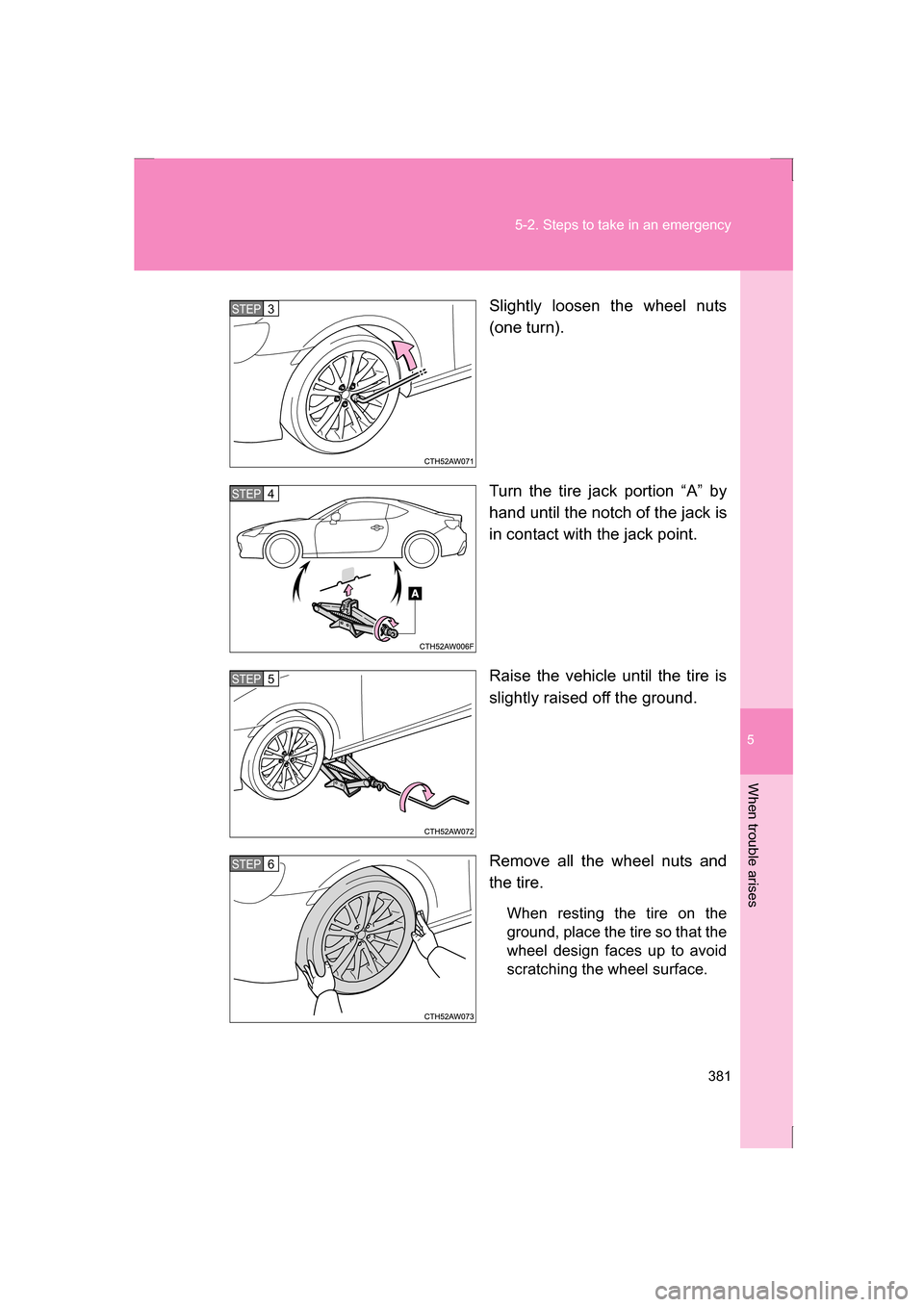
5
When trouble arises
381
5-2. Steps to take in an emergency
Slightly loosen the wheel nuts
(one turn).
Turn the tire jack portion “A” by
hand until the notch of the jack is
in contact with the jack point.
Raise the vehicle until the tire is
slightly raised off the ground.
Remove all the wheel nuts and
the tire.When resting the tire on the
ground, place the tire so that the
wheel design faces up to avoid
scratching the wheel surface.STEP 3
STEP 4
STEP 5
STEP 6
Page 382 of 484
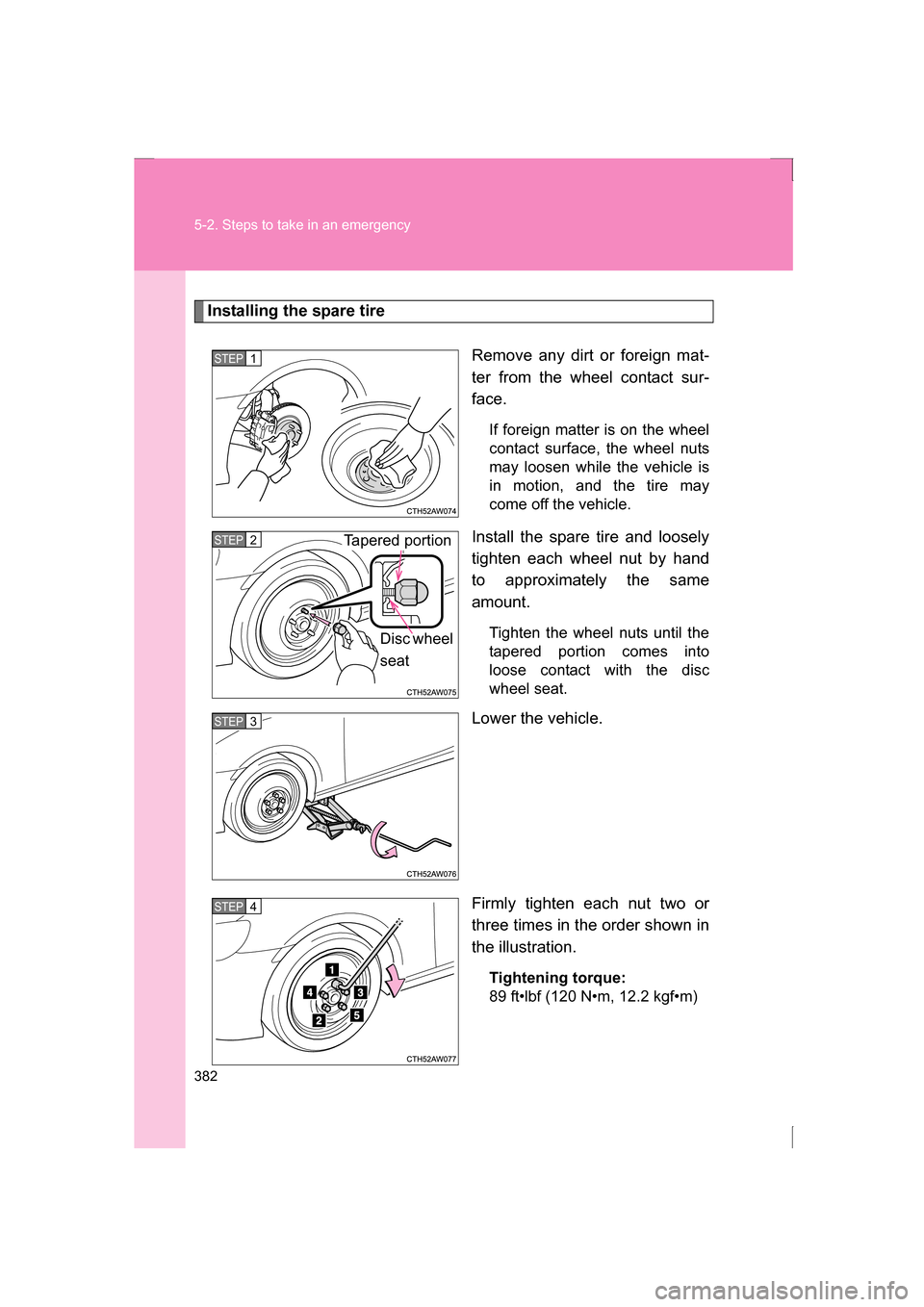
382
5-2. Steps to take in an emergency
Installing the spare tireRemove any dirt or foreign mat-
ter from the wheel contact sur-
face.If foreign matter is on the wheel
contact surface, the wheel nuts
may loosen while the vehicle is
in motion, and the tire may
come off the vehicle.
Install the spare tire and loosely
tighten each wheel nut by hand
to approximately the same
amount. Tighten the wheel nuts until the
tapered portion comes into
loose contact with the disc
wheel seat.
Lower the vehicle.
Firmly tighten each nut two or
three times in the order shown in
the illustration.
Tightening torque:
89 ft
Page 383 of 484
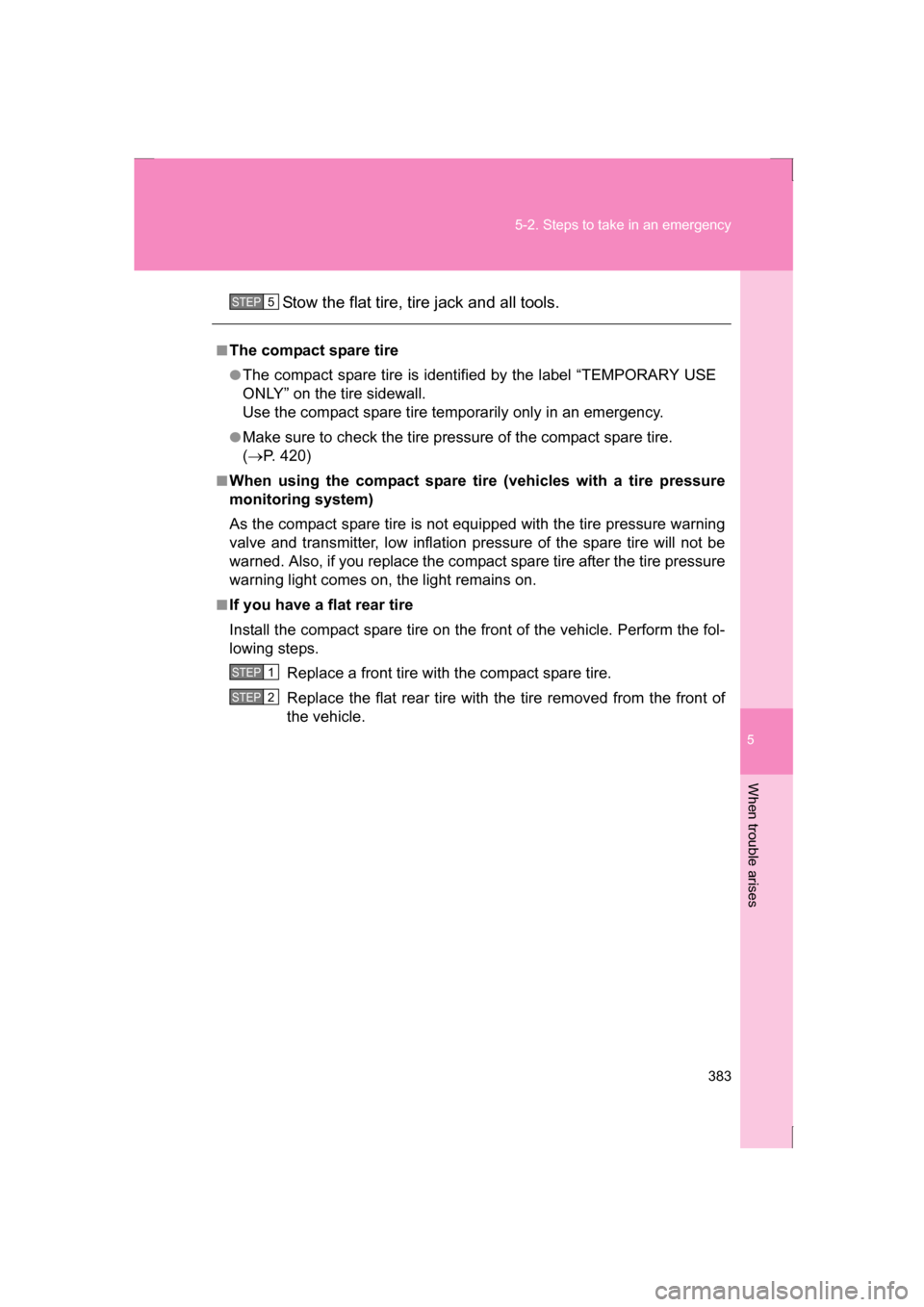
5
When trouble arises
383
5-2. Steps to take in an emergency
Stow the flat tire, tire jack and all tools.
■The compact spare tire
●The compact spare tire is identified by the label “TEMPORARY USE
ONLY” on the tire sidewall.
Use the compact spare tire temporarily only in an emergency.
●Make sure to check the tire pressure of the compact spare tire. (→ P. 420)
■When using the compact spare tire (vehicles with a tire pressure
monitoring system)
As the compact spare tire is not equipped with the tire pressure warning
valve and transmitter, low inflation pressure of the spare tire will not be
warned. Also, if you replace the compact spare tire after the tire pressure
warning light comes on, the light remains on.
■If you have a flat rear tire
Install the compact spare tire on the front of the vehicle. Perform the fol-
lowing steps.
Replace a front tire with the compact spare tire.
Replace the flat rear tire with the tire removed from the front of
the vehicle.
STEP 5
STEP 1
STEP 2
Page 384 of 484

384
5-2. Steps to take in an emergency
■After completing the tire change (vehicles with a tire pressure mon-
itoring system)
The tire pressure monitoring system must be reset. (→P. 309)
■Storing the tire
Always install the center fastener as shown in the illustration below.
Compact spare tire
Except compact spare tire
■Installing the wheel ornament (vehicles with steel wheels)
After installing “A” as shown in the illus-
tration, push the center ornament claws
in the order shown in the illustration
using a flathead screwdriver.
To prevent damage to the wheel and
wheel ornament, cover the tip of the
flathead screwdriver with a rag.
Page 385 of 484

5
When trouble arises
385
5-2. Steps to take in an emergency
WARNING
■Using the tire jack
Improper use of the tire jack may lead to death or serious injuries due to
the vehicle suddenly falling off the jack.
●Do not use the tire jack for any purpose other than replacing tires or
installing and removing tire chains.
●Only use the tire jack that comes with this vehicle for replacing a flat
tire.
Do not use it on other vehicles, and do not use other tire jacks for
replacing tires on this vehicle.
●Always check that the tire jack is securely set to the jack point.
●Do not put any part of your body under the vehicle supported by a jack.
●Do not start or run the engine while your vehicle is supported by the
jack.
●Do not raise the vehicle while someone is in it.
●When raising the vehicle, do not put an object on or under the jack.
●Do not raise the vehicle to a height greater than that required to
replace the tire.
●Use a jack stand if it is necessary to get under the vehicle.
Take particular care when lowering the vehicle to ensure that no one
working on or near the vehicle may be injured.
Page 386 of 484
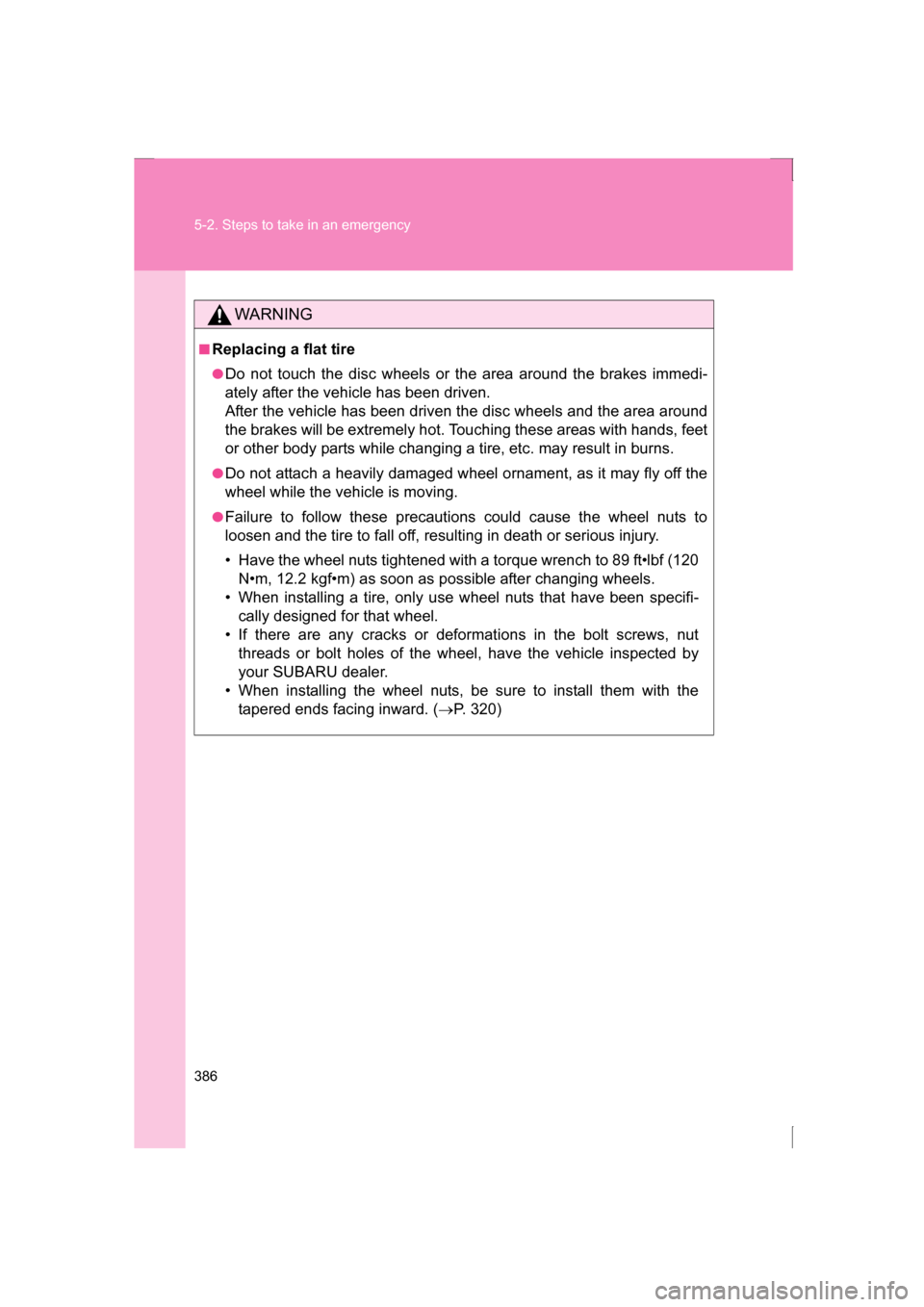
386
5-2. Steps to take in an emergency
WARNING
■Replacing a flat tire
●Do not touch the disc wheels or the area around the brakes immedi-
ately after the vehicle has been driven.
After the vehicle has been driven the disc wheels and the area around
the brakes will be extremely hot. Touching these areas with hands, feet
or other body parts while changing a tire, etc. may result in burns.
●Do not attach a heavily damaged wheel ornament, as it may fly off the
wheel while the vehicle is moving.
●Failure to follow these precautions could cause the wheel nuts to
loosen and the tire to fall off, resulting in death or serious injury.
Page 387 of 484
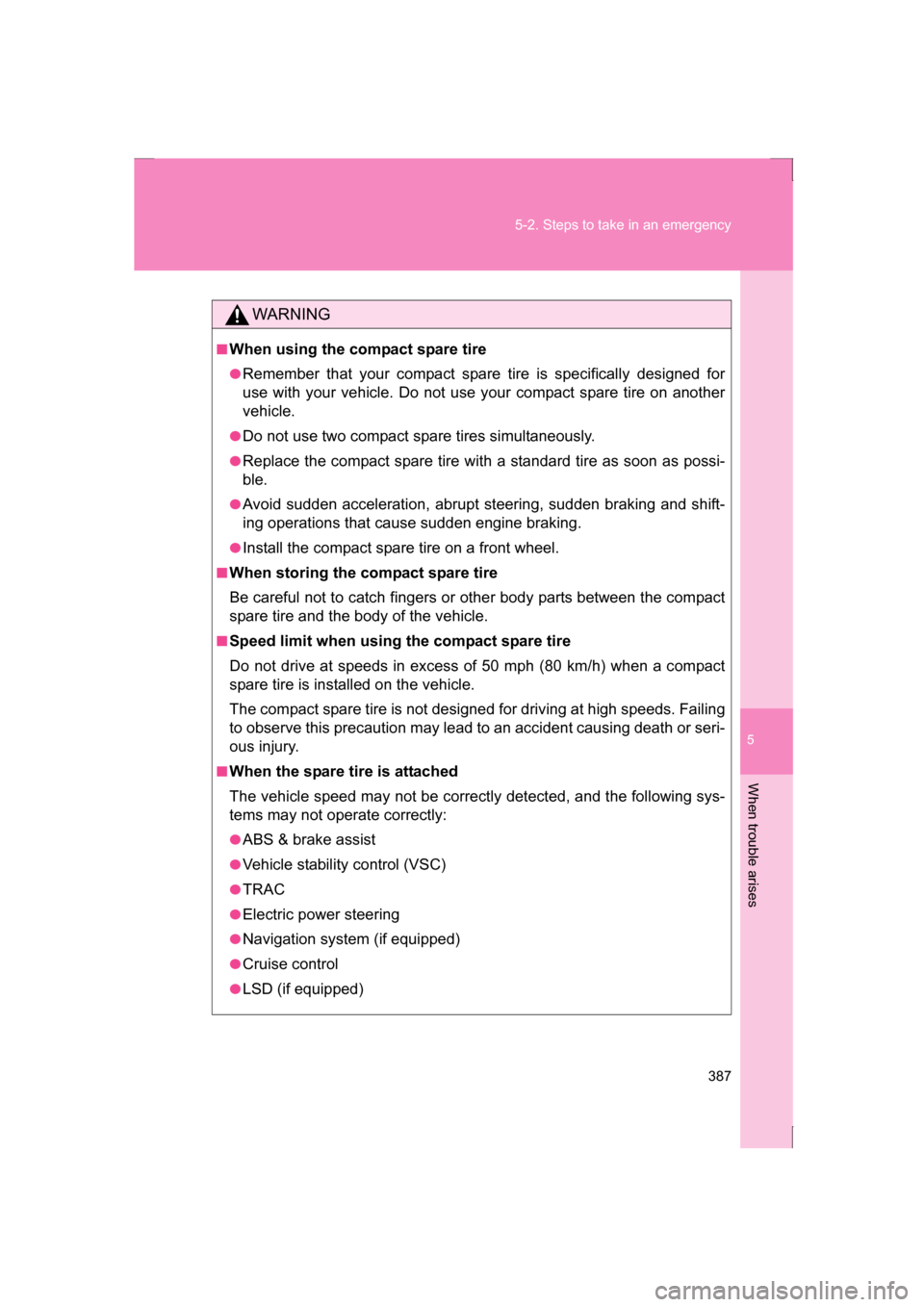
5
When trouble arises
387
5-2. Steps to take in an emergency
WARNING
■When using the compact spare tire
●Remember that your compact spare tire is specifically designed for
use with your vehicle. Do not use your compact spare tire on another
vehicle.
●Do not use two compact spare tires simultaneously.
●Replace the compact spare tire with a standard tire as soon as possi-
ble.
●Avoid sudden acceleration, abrupt steering, sudden braking and shift-
ing operations that cause sudden engine braking.
●Install the compact spare tire on a front wheel.
■When storing the compact spare tire
Be careful not to catch fingers or other body parts between the compact
spare tire and the body of the vehicle.
■Speed limit when using the compact spare tire
Do not drive at speeds in excess of 50 mph (80 km/h) when a compact
spare tire is installed on the vehicle.
The compact spare tire is not designed for driving at high speeds. Failing
to observe this precaution may lead to an accident causing death or seri-
ous injury.
■When the spare tire is attached
The vehicle speed may not be correctly detected, and the following sys-
tems may not operate correctly:
●ABS & brake assist
●Vehicle stability control (VSC)
●TRAC
●Electric power steering
●Navigation system (if equipped)
●Cruise control
●LSD (if equipped)
Page 388 of 484
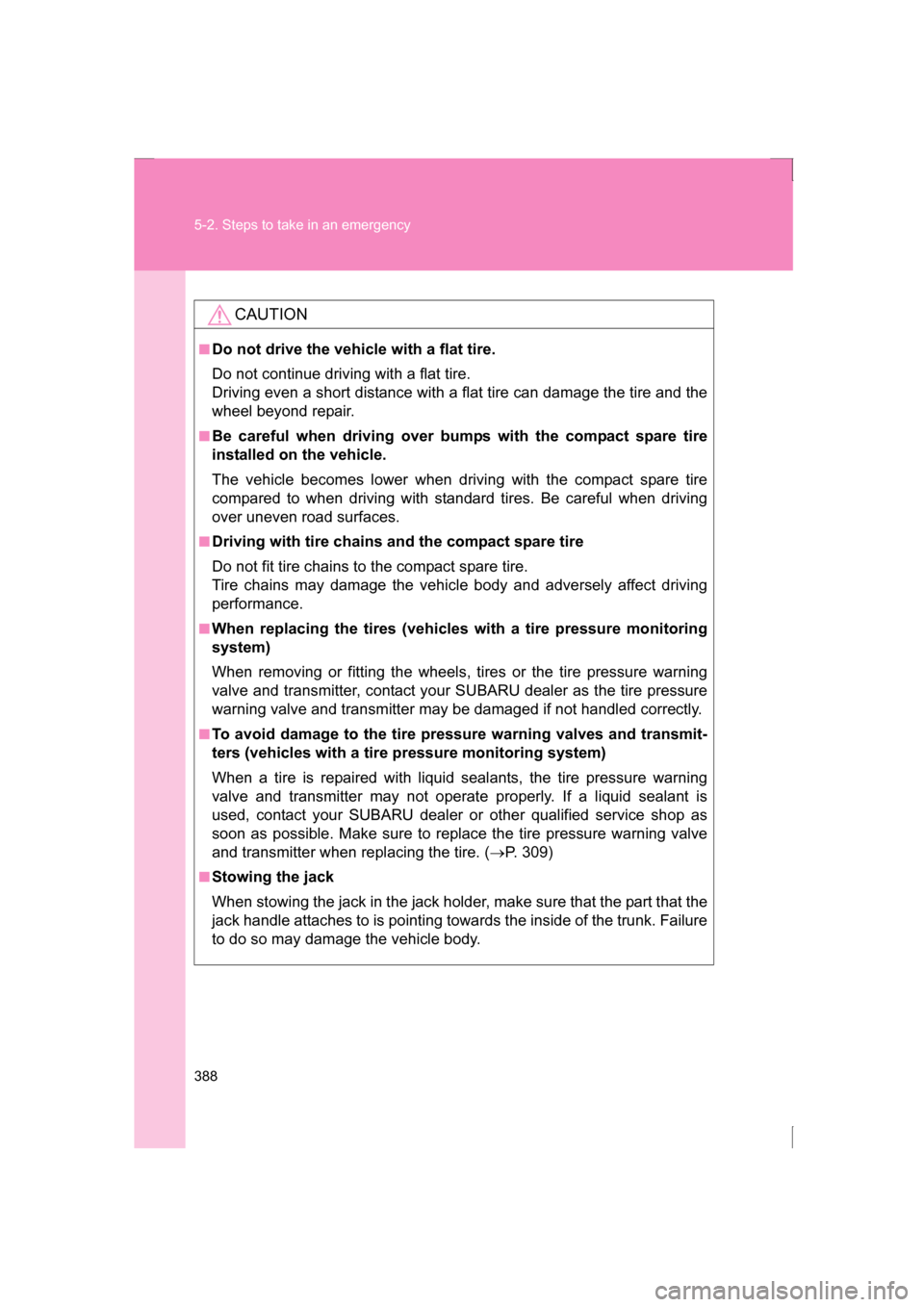
388
5-2. Steps to take in an emergency
CAUTION
■Do not drive the vehicle with a flat tire.
Do not continue driving with a flat tire.
Driving even a short distance with a flat tire can damage the tire and the
wheel beyond repair.
■Be careful when driving over bumps with the compact spare tire
installed on the vehicle.
The vehicle becomes lower when driving with the compact spare tire
compared to when driving with standard tires. Be careful when driving
over uneven road surfaces.
■Driving with tire chains and the compact spare tire
Do not fit tire chains to the compact spare tire.
Tire chains may damage the vehicle body and adversely affect driving
performance.
■When replacing the tires (vehicles with a tire pressure monitoring
system)
When removing or fitting the wheels, tires or the tire pressure warning
valve and transmitter, contact your SUBARU dealer as the tire pressure
warning valve and transmitter may be damaged if not handled correctly.
■To avoid damage to the tire pressure warning valves and transmit-
ters (vehicles with a tire pressure monitoring system)
When a tire is repaired with liquid sealants, the tire pressure warning
valve and transmitter may not operate properly. If a liquid sealant is
used, contact your SUBARU dealer or other qualified service shop as
soon as possible. Make sure to replace the tire pressure warning valve
and transmitter when replacing the tire. (→P. 309)
■Stowing the jack
When stowing the jack in the jack holder, make sure that the part that the
jack handle attaches to is pointing towards the inside of the trunk. Failure
to do so may damage the vehicle body.
Page 389 of 484
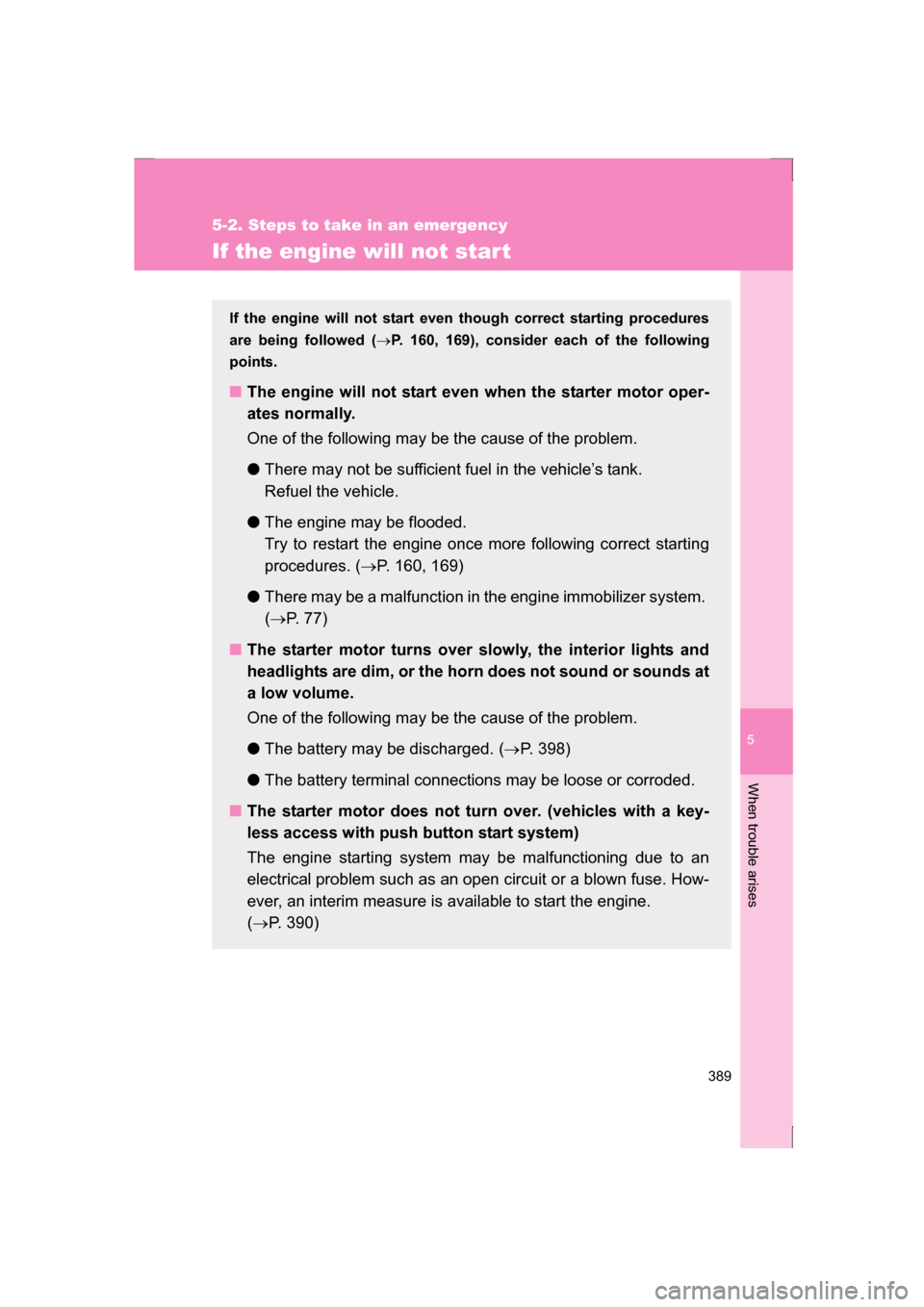
5
When trouble arises
389
5-2. Steps to take in an emergency
If the engine will not start
If the engine will not start even though correct starting procedures
are being followed ( →P. 160, 169), consider each of the following
points.
■The engine will not start even when the starter motor oper-
ates normally.
One of the following may be the cause of the problem. ● There may not be sufficient fuel in the vehicle’s tank.
Refuel the vehicle.
● The engine may be flooded.
Try to restart the engine once more following correct starting
procedures. ( →P. 160, 169)
● There may be a malfunction in the engine immobilizer system. (→ P. 77)
■The starter motor turns over slowly, the interior lights and
headlights are dim, or the horn does not sound or sounds at
a low volume.
One of the following may be the cause of the problem. ● The battery may be discharged. ( →P. 398)
● The battery terminal connections may be loose or corroded.
■The starter motor does not turn over. (vehicles with a key-
less access with push button start system)
The engine starting system may be malfunctioning due to an
electrical problem such as an open circuit or a blown fuse. How-
ever, an interim measure is available to start the engine. (→ P. 390)
Page 390 of 484
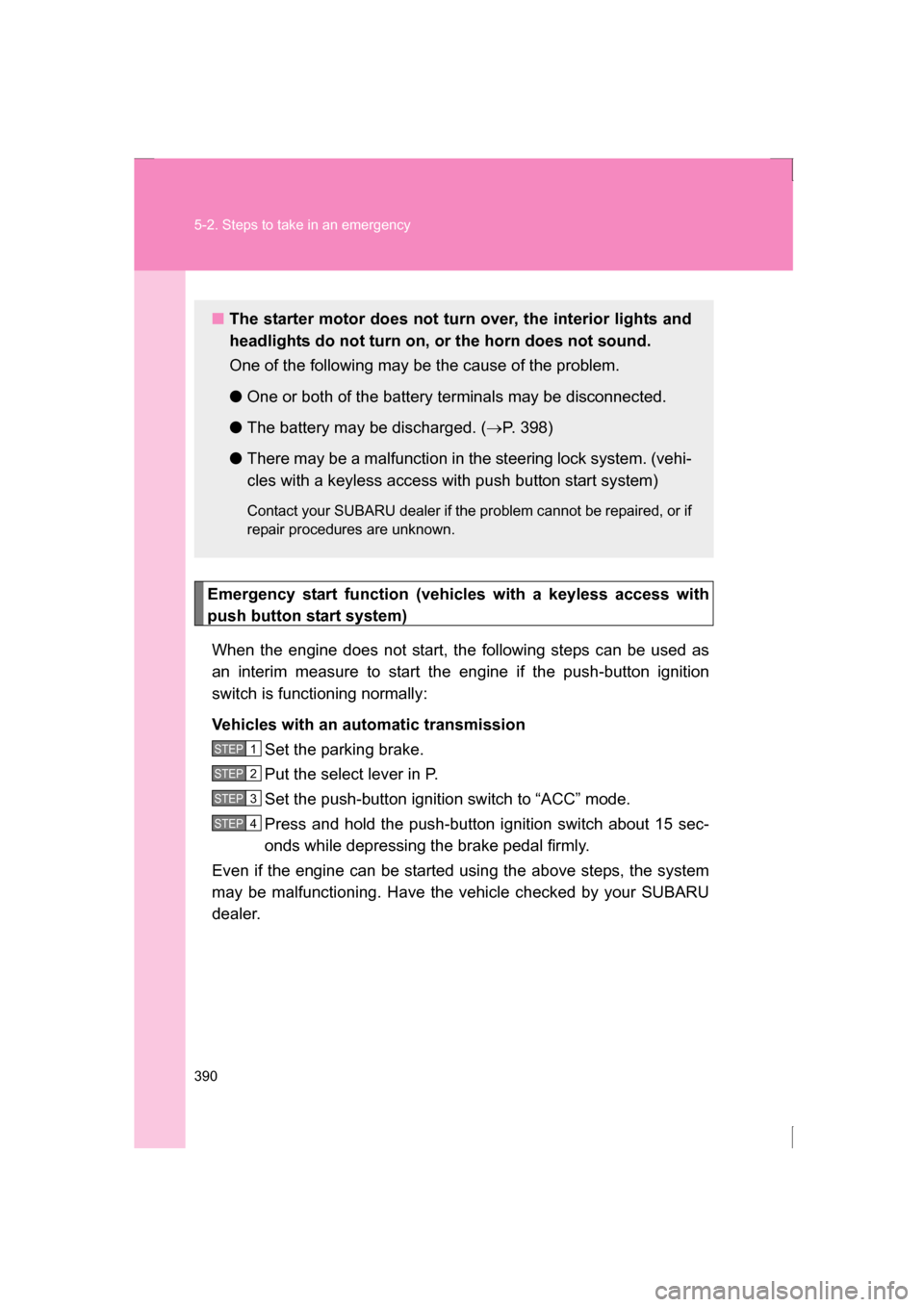
390
5-2. Steps to take in an emergency
Emergency start function (vehicles with a keyless access with
push button start system)When the engine does not start, the following steps can be used as
an interim measure to start the engine if the push-button ignition
switch is functioning normally:
Vehicles with an automatic transmission Set the parking brake.
Put the select lever in P.
Set the push-button ignition switch to “ACC” mode.
Press and hold the push-button ignition switch about 15 sec-
onds while depressing the brake pedal firmly.
Even if the engine can be started using the above steps, the system
may be malfunctioning. Have the vehicle checked by your SUBARU
dealer.
■The starter motor does not turn over, the interior lights and
headlights do not turn on, or the horn does not sound.
One of the following may be the cause of the problem. ● One or both of the battery terminals may be disconnected.
● The battery may be discharged. ( →P. 398)
● There may be a malfunction in the steering lock system. (vehi-
cles with a keyless access with push button start system)
Contact your SUBARU dealer if the problem cannot be repaired, or if
repair procedures are unknown.
STEP 1
STEP 2
STEP 3
STEP 4